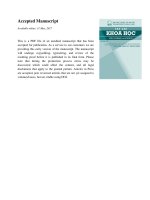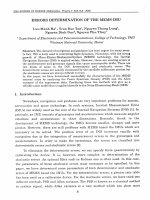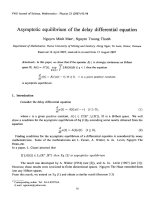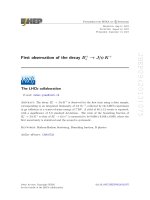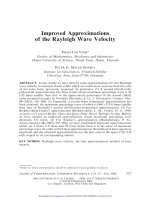DSpace at VNU: Improving performance of the asynchronous cooperative relay networks with maximum ratio combining and transmit antenna selection technique
Bạn đang xem bản rút gọn của tài liệu. Xem và tải ngay bản đầy đủ của tài liệu tại đây (371.5 KB, 9 trang )
Accepted Manuscript
Available online: 31 May, 2017
This is a PDF file of an unedited manuscript that has been
accepted for publication. As a service to our customers we are
providing this early version of the manuscript. The manuscript
will undergo copyediting, typesetting, and review of the
resulting proof before it is published in its final form. Please
note that during the production process errors may be
discovered which could affect the content, and all legal
disclaimers that apply to the journal pertain. Articles in Press
are accepted, peer reviewed articles that are not yet assigned to
volumes/issues, but are citable using DOI.
VNU Journal of Science: Comp. Science & Com. Eng., Vol. 33, No. 1 (2017) 28–35
Improving performance of the asynchronous cooperative relay
network with maximum ratio combining and transmit antenna
selection technique
The Nghiep Tran∗, Van Bien Pham, Huu Minh Nguyen
Faculty of Radio-Electronics, Le Quy Don Technical University,
236 Hoang Quoc Viet Street, Cau Giay, Hanoi, Vietnam
Abstract
In this paper, a new amplify and forward (AF) asynchronous cooperative relay network using maximum ratio
combining (MRC) and transmit antenna selection (TAS) technique is considered. In order to obtain a maximal
received diversity gain, the received signal vectors from all antennas of the each relay node are jointly combined
by MRC technique in the first phase. Then, one antenna of each relay node is selected for forwarding MRC
signal vectors to the destination node in the second phase. The proposed scheme not only offers to reduce the
interference components induced by inter-symbol interference (ISI) among the relay nodes, but also can effectively
remove them with employment near-optimum detection (NOD) at the destination node as compared to the previous
distributed close loop extended-orthogonal space time block code (DCL EO-STBC) scheme. The analysis and
simulation results confirm that the new scheme outperforms the previous cooperative relay networks in both
synchronous and asynchronous conditions. Moreover, the proposed scheme allows to reduce the requirement of the
Radio-Frequency (RF) chains at the relay nodes and is extended to general multi-antenna relay network without
decreasing transmission rate.
Received 22 April 2017, Revised 23 April 2017, Accepted 24 April 2017
Keywords: Maximum ratio combining, transmit antenna selection, near-optimum detection, distributed space-time
coding, distributed close-loop extended orthogonal space time block code.
1. Introduction
signals are amplified then transmitted to the
destination node, and (2) decode and forward (DF)
[7-12], that decodes the received signal from the
source, re-encode the decoded data, and transmit to
the destination node. This paper focuses on simple
relaying protocols based on amplify and forward
strategy since it is easier to implement them in the
small relay nodes and moreover, it does not require
the knowledge of the channel fading gains at the
relay nodes. Therefore, we can avoid imposing
bottlenecks on the rate by requiring some relays
to decode.
Space-time block coding (STBC) can be
employed in the distributed manner, referred as
a distributed STBC (DSTC), to exploit the spatial
diversity available more efficiently and provide
coding gain in these networks. Generally, there are
two types of relaying methods that were discussed
in the literatures: (1) amplify and forward (AF)
[1-6], that is linear process, in which the received
∗
Corresponding author. Email:
/>
28
T. N. Tran et al. / VNU Journal of Science: Comp. Science & Com. Eng., Vol. 33, No. 1 (2017) 28–35
29
DCL QO-STBC group
Time slot 1
Time slot 2
Time slot 3
Time slot 4
Ant 1 R1
t11(1, n )
t11(2, n )
t11(3, n )
t11(4, n )
Ant 2 R1
t21(1, n )
t21(2, n)
t21(3, n)
t21(4, n)
Ant 1 R2
t12(4, n - 1)
t12(1, n)
t12(2, n)
t12 (3, n)
t12(4, n)
Ant 2 R2
t22(4, n - 1)
t22(1, n )
t22(2, n )
t22(3, n )
t22(4, n )
ik (Delay time )
T
a) ISI presentation for DCL QO-STBC [2].
ISI from the previous
transmitted block of symbol
ISI from the current
transmitted block of symbol
DCL EO-STBC group
Time slot 1
Time slot 2
Ant 1 R1
t11(1, n )
t11(2, n )
Ant 2 R1
t21(1, n)
t21(2, n)
Ant 1 R2
t12(1, n - 1)
t12(1, n)
Ant 2 R2
t22(1, n - 1)
t22(1, n )
ik (Delay time )
t12(2, n)
t22(2, n )
T
b) ISI presentation for DCL EO-STBC [1].
Fig. 1. Example number of ISI components for DCL EO-STBC [1] and DCL QO-STBC [2].
The distributed close loop extended orthogonal
space time block code (DCL EO-STBC) [1] and
distributed close loop quasi-orthogonal space time
block code (DCL QO-STBC) [2] are proposed for
two dual-antenna relay nodes in the AF strategy.
It has been shown that both the DCL EO-STBC
and DCL QO-STBC achieve cooperative diversity
order of four with unity data transmission rate
between the relay nodes and the destination node.
However, the existing research on DSTC schemes
[1], [2], [3], and [8], where each relay antenna
processes its received signal independently, so
that this received signal combining is not optimal
for multi-antenna relay networks because the
co-located antennas of the each relay are treated
as distributed antennas.
Additionally, due to the distributed nature
of cooperative relay nodes, the received DSTC
symbols at the destination node will damage the
orthogonal feature by introducing inter-symbol
interference (ISI) components and degrade
significantly the system performance. In the
asynchronous cooperative relay networks, the
number of ISI components depends on both the
structure of the DSTC and the number of the
imperfect synchronous links [11]. The Fig. 1
illustrates a representation of ISI components at
the received symbols for the DCL EO-STBC [1]
and DCL QO-STBC [2]. It could be evident that
the DCL EO-STBC scheme has less number of
ISI components than the DCL QO-STBC one.
Note that, they have the similar configuration
network and the imperfect synchronous channel
assumptions. Moreover, the destination node
uses the detection of interference cancellation,
called near-optimum detection (NOD) [1], [9] and
parallel interference cancellation detection [2], to
eliminate ISI components, which is only solution
at the receiver.
As mentioned earlier, although a lot of phase
feedback schemes can be proved to improve the
distributed close loop system performance, other
problems of these systems have to use all antennas
of the relay node for forwarding the signals to
the destination node. This improvement comes
along with an increase in complexity, size, and cost
in hardware design [5]. Moreover, the previous
DSTC schemes can not be directly applied on the
multi-antenna relay networks, where each relay
has more than two antennas.
In this paper, we propose the asynchronous
cooperative relay network using optimal MRC
technique for jointly combining received signals
from the source node. In the second phase, the
TAS technique utilizes at the relay nodes which
chooses the best antenna to retransmit the resulting
T. N. Tran et al. / VNU Journal of Science: Comp. Science & Com. Eng., Vol. 33, No. 1 (2017) 28–35
30
fi1
MRC
R1
TAS
gi1
Feedback
Source
fi2
MRC
TAS
gi2
Destination
R2
Fig. 2. The proposed cooperative relay network with
MRC/TAS technique.
signals to the destination. Different with all of
the above-mentioned papers, our proposed scheme
uses TAS technique to reduce the number of the ISI
components and the requirement of the RF chains.
Moreover, the destination node utilizes the NOD
to remove the ISI components effectively.
The rest of the paper is organized as follows:
In the Sec. 2, we describe a new asynchronous
cooperative relay network with the MRC and
TAS technique (MRC/TAS) at the relay nodes;
the Sec. 3 represents the application of the
near-optimum detection (NOD) at the destination
node for the proposed scheme; simulation results
and performance comparisons are represented in
Sec. 4; finally, the conclusion follows in Sec. 5.
Notations: the bold lowercase a and bold
uppercase A denote vector and matrix,
respectively; [.]T , [.]∗ , [.]H and . 2 denote
transpose, conjugate, Hermitian (complex
conjugate) and Frobenius, respectively; A
indicates the signal constellation.
NR antennas. It is assumed that there is no Direct
Transmission (DT) connection between the source
and the destination due to shadowing or too large
distance. The relay node operating is assumed in
half-duplex mode and AF strategy. The channel
coefficient from the source node to i th the antenna
of the k th relay node and the channel coefficient
from the i th antenna of the k th relay node to the
destination node indicate fik and gik (for k = 1, 2;
i = 1, ..., NR ), respectively. The noise terms of the
relay and destination node are assumed AWGN
with distribution CN(0, 1). The total transmission
power of one symbol is fixed as P (dB). Thus, the
optimal power allocation is adopted as follows [12]
P1 =
P
P
, P2 = ,
2
4
where P1 and P2 are the average transmission
power at the source and each relay
node, respectively.
2.1. In the first phase (broadcast phase)
The information symbols are transmitted from
the source node to the destination node via
two different phases. In the first phase, the
source node broadcasts the sequence of quadrature
phase-shift keying (QPSK), which is grouped into
symbol vector s(n) = [ s(1, n) −s∗ (2, n) ]T . The
received symbol vector at i th antenna of the k th
relay node is given by
rik (n) = P1 fik s(n) + vik (n),
for k = 1, 2; i = 1, ..., NR
2. The proposed asynchronous cooperative
relay network with MRC/TAS technique
In this paper, a new asynchronous cooperative
relay network with MRC and TAS technique is
considered as shown in Fig. 2. This model consists
of a source node, a destination node and two relay
nodes. Each terminal node, i.e. the source node
and the destination node, is equipped with a single
antenna while each relay node is equipped with
(1)
(2)
where vik (n) is the additive Gaussian noise vector
at each antenna of each relay node.
In the conventional DSTC scheme [1, 2], the
transmitted symbols from each relay antenna at the
same relay node is designed to be a linear function
of the received signal and its conjugate. It is clear
that this is not optimal for networks whose relays
have multiple antennas because the co-located
antennas of the same relay are treated as distributed
T. N. Tran et al. / VNU Journal of Science: Comp. Science & Com. Eng., Vol. 33, No. 1 (2017) 28–35
antennas. In order to achieve the optimal received
diversity gain, the received symbols at the each
relay node are combined by using MRC technique
as follow
∗
f1k
.
1
r1k (n) · · · rNR k (n) .. ,
rk (n) =
fk F
∗
fNR k
for k = 1, 2; i = 1, ..., NR ,
(3)
where rk (n) is received symbol vector at k th
relay node after using MRC process and fk F =
to different locations of the relay nodes. Therefore,
the received symbols at the destination node may
not align. Without loss of generality, we assume
that both antennas of the first relay node (denotes
R1 ) and the destination node are synchronized
perfectly, whereas both antennas of the second
relay node (denotes R2 ) and the destination node
are synchronized imperfectly (e.i. τ2 = τ12 =
τ22 0) as shown in Fig. 3. The received symbols
at the destination are written as follow
y(1, n) = t1 (1, n)g1 (n) + t2 (1, n)g2 (n)
+ t2 (2, n − 1)g2 (n − 1) + z(1, n),
2
| f1k |2 + · · · + fNR k . The transmitted symbol
vector from selected transmit antenna tk (n) is
described by a linear function of rk (n) and its
conjugate r∗k (n) as follow
tk (n) =
P2
Ak rk (n) + Bk r∗k (n) .
P1 + 1
(4)
This paper uses distributed matrices Ak , Bk with
Alamouti DSTC [13] to obtain a unity transmission
rate and√linear complexity detection. Note that, the
factor P2 /(P1 + 1) in the equation (4) ensures
that the average transmission power at each relay
node is P2 .
2.2. In the second phase (cooperative phase).
In the second phase, the transmit antenna
of each relay node can be selected by below
criterion [14], which achieves a maximal
transmitted diversity gain
u(k) = max |gik |2 ; for k = 1, 2; i = 1, ..., NR ,
i=1,...,NR
(5)
where u(k) is the selected transmit antenna index
of the k th relay node. gk (k = 1, 2) denotes the
channel gain from the selected transmit antenna of
the k th relay node to the destination node. The
TAS technique allows to achieve the transmitted
diversity gain in the second phase.
As the previous mention in [1-2], the transmitted
signals from the cooperative relay nodes to the
destination will undergo different time delays due
31
(6)
y(2, n) = t1 (2, n)g1 (n) + t2 (2, n)g2 (n)
+ t2 (1, n)g2 (n − 1) + z(2, n),
(7)
where z(n) is the additive Gaussian noise vector at
the destination. By substituting (4) into (6) and (7),
then taking the conjugate of y(2, n), the received
symbols at the destination can be rewritten as
y(1, n) =
+
P2 P1
1 + P1
f1 F g1(n)s(1, n) + f2 F g2(n)s(2, n)
P2 P1
f2 F g2(n − 1)s∗(1, n − 1)
1 + P1
P2
g1(n)v1(1, n) − g2(n)v∗2(2, n)
1 + P1
+ z(1, n),
+
P2 P1
1 + P1
y∗(2, n) =
+
(8)
f2 F g∗2(n)s(1, n) − f1 F g∗1(n)s(2, n)
P2 P1 ∗
g (n − 1)s∗(2, n)
1 + P1 2
P2
g∗ (n)v∗ (2, n) + g∗2(n)v2(1, n)
1 + P1 1 1
+ z∗(2, n),
+
(9)
The equation (8) and (9) can be rewritten in
vector form as
y (n) =
y(1, n)
y∗ (2, n)
P2 P1
Hs (n) +
1 + P1
+ w(n),
=
P2 P1
Iint (n)
1 + P1
(10)
T. N. Tran et al. / VNU Journal of Science: Comp. Science & Com. Eng., Vol. 33, No. 1 (2017) 28–35
32
Previous DSTC group
Selec. anten. at
R1
Selec. anten. at
R2
Current DSTC group
Time slot 1
Time slot 2
Time slot 1
Time slot 2
t1(1, n - 1)
t1(2, n - 1)
t1(1, n)
t1(2, n)
t2(2, n - 1)
t2(1, n - 1)
Time delay 2
t2 (1, n)
t2 (2, n)
T
Fig. 3. Representation of ISI components between the selected transmit relay antenna and the destination antenna.
where
f1 F g1 (n)
f2 F g∗2 (n)
H=
Iint (n) =
Iint (1, n)
Iint (2, n)
s(1, n)
s(2, n)
,
f2 F g2 (n − 1)s∗ (1, n − 1)
f1 F g∗2 (n − 1)s∗ (2, n)
,
f2 F g2 (n)
− f1 F g∗1 (n)
=
; s (n) =
3. Near-Optimum Detection (NOD) for the
proposed scheme
and
w(n) =
P2
1 + P1
+
z(1, n)
z∗ (2, n)
g1 (n)v1 (1, n) − g2 (n)v∗2 (2, n)
g∗1 (n)v∗1 (2, n) + g∗2 (n)v2 (1, n)
.
As similar literatures, the effects of ISIs from
the previous symbols in (8) and (9) are represented
by g2 (n − 1). The strengths of g2 (n − 1) can be
expressed as a ratio as [1]:
β = |g2 (n − 1)|2 /|g2 (n)|2 .
as comparison to the previous cooperative relay
networks. However, the number of feedback bits
of the proposed scheme is quite larger than the
DCL EO-STBC scheme. It is a reasonable price
for the advantages of the proposed scheme.
(11)
The second term of (10), i.e. Iint (, n) called
ISI components, and the Fig. 3 give that the
received symbols at the destination have two ISI
components. The ISI components of proposed
scheme are reduced in compared to the previous
DSTC schemes [1, 2] (See Fig. 1 in Section
1). It is important that the number of ISI
components of the proposed scheme always equals
two and is independent of the number of the
transmitted relay-antennas. Moreover, the above
analyses show that the TAS technique not only
allows to reduce the requirement of RF chains
at the relay nodes, but also increases at twice
the transmit power at each transmitted antenna
As remarked above, although the number of
ISI components have been reduced by using TAS
technique, the ISI components have still existed
in the received symbol vector at the destination
node. The existing ISI components can lead to
substantial degradation in system performance. To
the end this lack of the asynchronous cooperative
relay network, the near-optimum detection (NOD)
scheme is employed at the destination node before
the information detection. In fact, the symbol
s(1, n − 1) is known through the use of pilot
symbols at the start of the packet. Therefore, the
interference components Iint (1, n) = f2 F g2 (n −
1)s∗ (1, n − 1) in the equation (10) can effectively
eliminate as follows:
Step 1: Remove the ISI components
yˆ (n) =
y (1, n) − Iint (1, n)
y (2, n)
(12)
Step 2: Apply the matched filter by multiplying
the signals removed the ISI components in (12)
by HH . Therefore, the estimated signals can be
T. N. Tran et al. / VNU Journal of Science: Comp. Science & Com. Eng., Vol. 33, No. 1 (2017) 28–35
Similarly, substituting s˜(2, n) back to the
equation (15), y (1, n) also is only related to
s(1, n). Therefore, s˜(1, n) can be detected by
represented as
y (1, n)
y (2, n)
y (n) =
= HH yˆ (n)
P1 P2
(∆s (n) + Λs∗ (2, n)) + wD (n),
P1 + 1
(13)
=
where y (1, n) and y (2, n) are given by
P1 P2
(λs(2, n) + Λ(2, n)s∗ (2, n))
P1 + 1
+ wD (2, n),
(14)
y (2, n) =
P1 P2
(λs(1, n) + Λ(1, n)s∗ (2, n))
P1 + 1
+ wD (1, n),
(15)
y (1, n) =
with
∆=H H=
H
Λ = HH
λ 0
, λ=
0 λ
2
fk
2
F
and wD (n) = HH w(n).
Step 3: Apply the Least Square (LS) at the
destination to estimate the transmitted signals from
the source node.
As seen the equation (14) y (2, n) is only
related to s(2, n). In addition, it can be proved
that wD (2, n) is a circularly symmetric Gaussian
random variable with zero-mean and covariance
σ2W . Assuming the CSI at the destination node,
s˜(2, n) can be detected as follow
P1P2
(λs(2, n)
P1 + 1
(16)
+ Λ(2, n)s (2, n))|2.
where s(2, n)
transmitted symbol.
∈
A
s(1,n)∈A
∗
+ Λ(1, n)˜s (2, n))|2.
P1P2
(λs(1, n)
P1 + 1
(17)
Due to the presence of the interference
component Iint (n) in (10), which will destroy
the orthogonality of the received signal causing
a degradation in the system performance when
the conventional detector, e.g., the maximum
likelihood without interference cancellation, uses
at the destination node [1]. However, the received
symbol y (2, n) in the equation (14) has no ISI
component via the using NOD. It is noticeable
from this equation that the application of the
NOD at the destination effectively removes the
interference components due to the impact of
imperfect synchronous among the relay nodes.
4. Comparison results
0
,
∗
f1 F g2 (n − 1)s∗ (2, n)
s(2,n)∈A
∗
s˜(1, n) = arg min |y (1, n) −
|gk (n)|2 ,
k=1
s˜(2, n) = arg min |y (2, n) −
33
is
possible
In this section, we present some numerical
results to demonstrate the performance of our
proposed cooperative relay network with MRC
and TAS technique. In all figures, the bit error
rates (BER) are shown as a function of the total
transmit power in the whole network. The transmit
information symbols are chosen independently
and uniformly from QPSK constellation. It is
assumed that all channels are quasi-static Rayleigh
fading channels. The destination node completely
acquires the channel information states from
the source to the relays and from the relays to
the destination.
Firstly, Fig. 4 illustrates the BER performance
of the proposed MRC/TAS DSTC and DCL
EO-STBC scheme [1] in the perfect synchronous
case where each relay node equips two antennas.
As seen the Fig. 4, the proposed scheme
outperforms the previous DCL EO-STBC scheme.
For example, to achieve a BER = 10−3 we need
T. N. Tran et al. / VNU Journal of Science: Comp. Science & Com. Eng., Vol. 33, No. 1 (2017) 28–35
34
0
0
10
10
−1
−1
10
10
−2
−2
10
BER
BER
10
−3
−3
10
10
DCL EO−STBC NOD β= 0 dB [1]
DCL EO−STBC NOD β= −6 dB [1]
−4
10
MRC/TAS DSTC N =2; NOD β= 0 dB
−4
10
DCL EO−STBC Scheme (PS) [1]
Proposed MRC/TAS DSTC NR=2; (PS)
R
MRC/TAS DSTC N =2; NOD β= −6 dB
R
Proposed MRC/TAS DSTC NR=3; (PS)
0
5
10
15
P (Total Power) in dB
Proposed MRC/TAS DSTC (PS)
20
25
Fig. 4. BER performance comparison of the proposed
MRC/TAS and DCL EO-STBC scheme [1] in the perfect
synchronous case.
P of ∼17 dB for the proposed MRC/TAS DSTC
scheme and ∼21 dB for the DCL EO-STBC
scheme. Secondly, the system performance of
the MRC/TAS DSTC is simulated in the perfect
synchronous assumption and using three antennas
at each relay. The left curve of the Fig. 4 shows
that the system performance of proposed scheme is
improved considerably with increasing the number
of antennas of each relay node. The improvement
of the proposed scheme is because that our scheme
achieves both maximal received diversity gain in
the first phase and cooperative transmit diversity
gain in the second phase. Moreover, the proposed
scheme has less requirement of RF chains of
the relay than the previous works and remains
unity transmission rate between the relay and
the destination.
The impact of imperfect synchronization is
performed by changing the value of β =
0, −6 dB, which means adjusting the effect
of different time delays. Fig. 5 shows the
BER performance comparisons of the proposed
MRC/TAS DSTC scheme and the previous DCL
EO-STBC scheme [1] with the utilizing NOD at
the destination node. In this case, the MRC/TAS
DSTC scheme has similar configuration network
as comparison with DCL EO-STBC scheme [1].
The BER performance of the proposed scheme
outweighs the previous cooperative relay network.
As shown in Fig. 5, when the BER is 10−3 (at
0
5
10
15
P (Total Power) in dB
20
25
Fig. 5. BER performance comparison of the MRC/TAS
DSTC (NR = 2) and the DCL EO-STBC [1] with the
utilizing NOD scheme.
β = −6 dB), the proposed scheme can get an
approximate 5 dB gain over the DCL EO-STBC
scheme. It could be noticeable that the proposed
MRC/TAS DSTC scheme is more robust against
the effect of the asynchronous.
In order to examine the advantages of increasing
the number of the relay-antennas, the BER of the
proposed scheme is performed with three antennas
at each relay node and various asynchronous
channel conditions. The Fig. 6 demonstrates
that the MRC/TAS DSTC scheme owning three
relay-antennas has greater system performance
than, in the similar asynchronous condition, the
DCL EO-STBC one using two antennas at each
relay node. For example, at the BER of 10−3 (at
β = −6 dB), the proposed scheme can obtain
about 9 dB gain over the DCL EO-STBC one.
The enhancing performance is achieved as the
MRC/TAS DTSC scheme can get a higher gain
including both received and transmitted diversity.
5. Conclusions
This paper proposes the AF asynchronous
cooperative relay network using MRC and TAS
technique. The use of MRC technique for
combining multiple received symbols is proved
to obtain maximal received diversity gain in
compared to conventional DSTC scheme [1,2].
In the second phase, the TAS technique allows
to reduce the ISI components among the relay
T. N. Tran et al. / VNU Journal of Science: Comp. Science & Com. Eng., Vol. 33, No. 1 (2017) 28–35
0
10
−1
10
−2
BER
10
−3
10
DCL EO−STBC NOD β= 0 dB [1]
DCL EO−STBC NOD β= −6 dB [1]
MRC/TAS DSTC NR=3; NOD β= 0 dB
−4
10
MRC/TAS DSTC NR=3; NOD β= −6 dB
Proposed MRC/TAS DSTC NR=3; (PS)
0
5
10
15
P (Total Power) in dB
20
25
Fig. 6. BER performance comparison of the MRC/TAS
DSTC (NR = 3) and the DCL EO-STBC [1] with the
utilizing NOD scheme.
nodes. The analyses and simulation results
demonstrate that the proposed scheme with the
employment of the NOD works effectively in
various synchronization error levels. In other
words, the MRS/TAS DSTC scheme is more
robust against the effect of the asynchronous.
The proposed scheme has less requirement of RF
chains at the relay and exploits the the advantage
of multi-antennas more effectively in comparison
to the previous one. We believe that the MRC/TAS
DSTC scheme can be useful for the distributed
relay networks using multi-antennas at the relay
nodes like sensor wireless network or Ad hoc
network under the asynchronous conditions.
References
[1] W. Qaja, A. Elazreg, and J. Chambers, “Near-Optimum
Detection for Use in Closed-Loop Distributed Space
Time Coding with Asynchronous Transmission and
Selection of Two Dual-Antenna Relays,” in Proc.
Wireless Conference (EW), Guildford, UK, Apr. 2013,
pp. 1-6.
[2] W. M. Qaja, A. M. Elazreg, and J. A. Chambers,
“Distributed Space Time Transmission with Two
Relay Selection and Parallel Interference Cancellation
Detection to Mitigate Asynchronism,” in Proc. European
Symposium on Computer Modeling and Simulation
(EMS), Valetta, Malta, Nov. 2012, pp. 220-225.
[3] Astal M-T EL, Abu-Hudrouss, Ammar M, and
Olivier Jan C, “Improved signal detection of wireless
35
relaying networks employing space-time block codes
under imperfect synchronization,” Wireless Personal
Communications, vol.82, no.1, pp. 533-550, 2015.
[4] Alageli, Mahmoud, Aissa Ikhlef, and Jonathon
Chambers, “Relay selection for asynchronous AF relay
networks with frequency selective channels,” in Proc.
Inter. Workshop on Signal Processing Advances in
Wireless Communi., Aug. 2016, pp. 1-5.
[5] Gonzalez, Diana Cristina, Daniel Benevides da Costa,
and Jose Candido Silveira Santos Filho, “Distributed
TAS/MRC and TAS/SC Schemes for Fixed-Gain AF
Systems With Multiantenna Relay: Outage Performance,”
IEEE Transac. on Wireless Communications, vol.15,
no.6, pp.4380-4392, 2016
[6] Y. Jing and B. Hassibi, “Distributed space-time coding
in wireless relay networks,” IEEE Trans. on Wireless
Comm., vol. 5. no. 12, pp. 3524-3536, Dec. 2006.
[7] Desouky, Ahmed, and Ahmed El-Mahdy, “Asynchronous
down-link cooperative communication scheme in
Rayleigh fading wireless environment,” in Proc. Signal
Processing: Algorithms, Architectures, Arrangements,
and Applications, 2016, pp.142-146.
[8] A. Elazreg and A. Kharaz, “Sub-Optimum Detection
Scheme for Distributed Closed-Loop Quasi Orthogonal
Space Time Block Coding in Asynchronous Cooperative
Two Dual-Antenna Relay Networks,” in Proc. Wireless
Internet, Lisbon, Portugal, 2015, pp. 217-228.
[9] W. M. Qaja, A. M. Elazreg, and J. A. Chambers,
“Near-optimum detection scheme with relay selection
technique for asynchronous cooperative relay networks,”
IET Comm., vol. 8, no. 8, pp. 1347-1354, May 2014.
[10] B. Kumbhani and R. S. Kshetrimayum, “Error
performance of two-hop decode and forward relaying
systems with source and relay transmit antenna selection,”
Electronics Letters, vol. 51, no. 6, pp. 530-532, 2015.
[11] M. T. O. E. Astal and J. C. Olivier, “Distributed
Closed-Loop Extended Orthogonal STBC: Improved
performance in imperfect synchronization,” in Proc.
Personal Indoor and Mobile Radio Communications
(PIMRC), London, England, Sept. 2013, pp. 1941-1945.
[12] J. Harshan and B. S. Rajan, “Co-ordinate interleaved
distributed space-time coding for two-antenna-relays
networks,” IEEE Trans. on Wireless Comm., vol. 8, no. 4,
pp. 1783-1791, Apr. 2009.
[13] Y. Jing and H. Jafarkhani, “Using Orthogonal and
Quasi-Orthogonal Designs in Wireless Relay Networks,”
IEEE Trans. on Infor. Theory, vol. 53, no. 11, pp.
4106-4118, 2007.
[14] D. A. Gore and A. J. Paulraj, “MIMO antenna subset
selection with space-time coding,” IEEE Trans. on Signal
Processing, vol. 50, no. 10, pp. 2580-2588, 2002.
